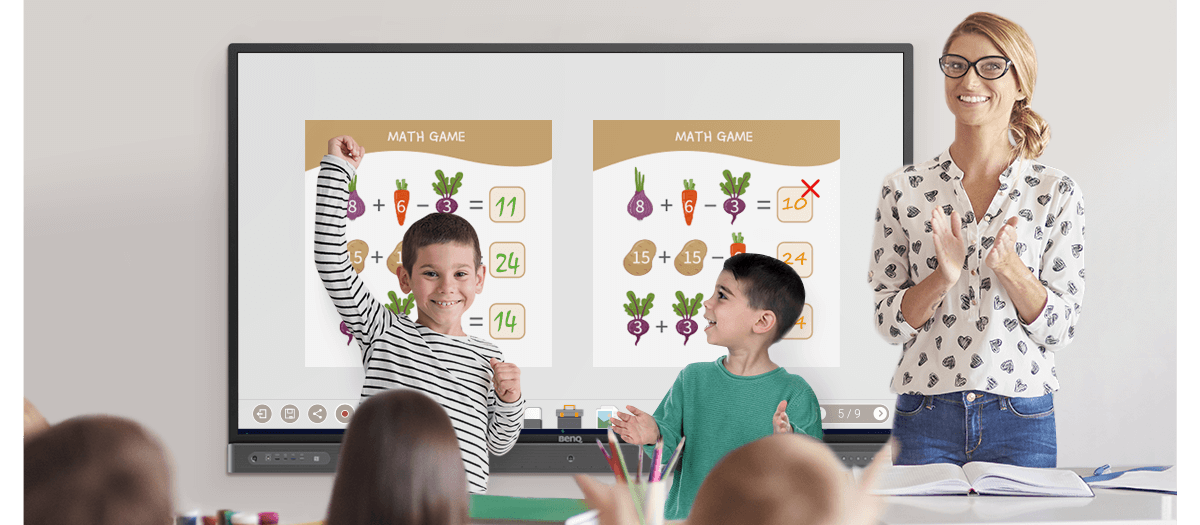Full STEAM Ahead – Interactive Displays at Schools
- BenQ
- 2021-03-05
STEM and STEAM concepts have grown in importance within the context of education over the past decade. With science, technology, engineering, and math forming the STEM from which education grows, STEAM adds art (hence the “A”) to provide a touch of extra creativity and expression. The two concepts rely heavily on flipped classroom models that emphasize students and proactive learning rather than learning by rote of a teacher-centric class.
In addition to their close relationship with emerging technology such as interactive displays, STEM/ STEAM education initiatives have strong ties to Google tools and solutions. This has become very evident after the official Google Classroom certification program kicked off. That's the very pertinent to the topic at hand, because most of the devices used in modern learning models, from smart boards to smart phones, run Android and make use of Google search and cloud storage services.
We would like to note that BenQ is a certified Google Classroom program partner and tech provider.
In any case, with the help of quality, full-featured interactive displays like those made by BenQ, STEAM and STEM educators have the tools needed to power towards better futures, whether engaged in fully in-class attendance or blended or hybrid learning where many students take part remotely.
Preparing Students for Technology-Focused Futures
Not just buzzwords, STEM and STEAM reflect a major change in education, as per this report from Forbes. They embody a thinking that calls for learning to be more practical and centered on hard science, so that kids grow up with skills necessary to secure good jobs and help improve society. STEM education seeks to both prepare students and provide benefit to humanity, as recent decades have seen declining interest in science, engineering, and math among students, resulting in real talent and skill shortages down the line. With STEM, students are encouraged to take on the challenges facing humanity, from new energy production methods to space exploration. STEAM is a variant of STEM that incorporates creativity and artistic expression, trying to embody the fusion of hard science and liberal arts.

What are the Challenges?
Because STEM/STEAM elevate the role of technology and interactive learning, they require a whole raft of new tools. These may be costly to integrate into schools, and also impose training curves on educators and students. Unlike liberal arts, where books and lectures are the primary tools, science needs various and more specific devices and toolsets. These include lab kits, testing equipment, video displays, and increasingly even 3D printers.
Interactive displays help mitigate some of those costs by providing a multi-role platform. For working on content, showing content, and classroom interaction, there’s nothing even remotely as effective as good interactive displays. And while ideally every student should have their own tablet or laptop while in class, in reality that’s usually not possible, and BenQ’s here to help. Interactive displays offer smart, intuitive, and easy to use platforms that are accessible to all students.
Benefits of Interactive Displays for Your STEM/STEAM Classrooms
With an interactive display that’s high quality, high fidelity, and easily accessible, you can simulate diverse experiments, tests, and processes that would normally be entirely physical. And physical means more complex and expensive. Chemistry and physics especially benefit from this, with interactive displays allowing for demonstrations that reach everyone in attendance and that respond to input in real time. For mathematics, equations and calculations appear to students with increased clarity and may be altered and modified instantly without the mess blackboards and whiteboards entail. Dedicated tools that work on interactive displays make math much easier for students to understand and enjoy.
Large and eye-catching interactive displays have a “wow” factor to them previously only found on big screen TVs or even movie theaters. Compared to the sleepy vibe of traditional classrooms with their largely non-interactive structure and old-fashioned books, smart classrooms with a focus on STEM/STEAM consistently prove to be more engaging. Greater engagement of course translates into improved knowledge retention and an overall better approach to learning on the part of students.

Without needing a lot of complex equipment, interactive displays offer a big and bold centerpiece for classrooms where knowledge and concepts can be clearly visualized in an attractive, engaging manner. A simple example of this may be something as mundane as a geography lesson. Whereas old style classes relied on atlases, with interactive displays teachers bring up Google Maps, Google Earth, and Google Street View to enable virtual school trips. That’s a lot more engaging that flipping pages in a large and heavy book, which rarely retains student interest for very long.
Specific Applications Abound
Interactive displays from BenQ help teachers in every aspect of the STEM/STEAM learning process. For example, programming classes may use the displays to work on code together. The high visibility provided by interactive displays and their ability to accommodate multiple users makes collaboration easy and fruitful.
Compatibility with nearly every media format comes in super handy for art classes, as images, audio, video, and text combine seamlessly and without any technical issues. Design, photography, and artwork all look more appealing on a big interactive display than in a small format on a laptop or as a static image in a book.
Earlier we mentioned improved engagement. Interactive displays provide a superb foundation for keeping students active and invested in learning. The so-called gamification of classes, where teaching also uses games and game-like objectives to motivate students, has a lot to gain from interactive displays. Today’s students instinctively relate to interactive, high resolution panels, which are very similar to other devices they use every day. That makes classroom gamification a far more attainable reality, a departure from the realm of book-based teaching modalities.

Flipped Classrooms Need Interactive Displays
Emerging classroom methodologies rely on hybrid learning, blended learning, and flipped learning. All of these boil down to a shift in the flow of learning. While of course teachers still provide knowledge, the driving force of the class has moved on to the students. Instead of lectures followed by homework, flipped classrooms have students do their own research and preparation at home, followed by discussion, collaboration, and verification in class. This approach allows students to take an initiative, explore topics in a way that appeals to them, and then delve deeper into said topics as guided by a teacher. As time passes, a growing body of evidence now indicates that flipped classes far outdo older teaching methods and models with regards to student engagement and success.
But to do that, flipped classrooms need the right tools, as we said before. And interactive displays form the basis for those tools and bring it all together for a successful STEM/STEAM curriculum.
Looking to the Future
The whole point of STEM/STEAM revolves around providing applicable skills instead of copious amounts of general, theoretical knowledge. The thinking is that with mass media and communications, people nowadays already have access to baseline knowledge from essentially anywhere, so there’s little need to spend time on such knowhow in classrooms. That time is better spent building up student skillsets towards brighter futures through great jobs and contributions to humanity. However, the road to STEM/STEAM success is paved with good technology, like BenQ interactive displays. Without those tools, educators will find it hard to achieve success and help their students.
Learn more about BenQ interactive displays and see why they’re windows to better futures for your students as the finest tools for all your modern classroom needs. There’s a lot to discover!

